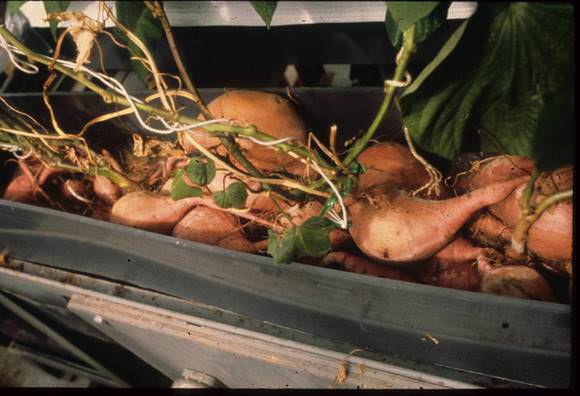[/caption]
A team of researchers from the Deep South sent sweet potato plants into space, as part of an experiment aimed at providing food for long-term space missions.
Desmond G. Mortley, from the G.W. Carver Agricultural Experiment Station at Alabama’s Tuskegee University, and his colleagues launched the sweet potato cuttings on a five-day mission aboard the space shuttle Columbia, and compared their success to ground-based cuttings at Kennedy Space Center in Florida.
“The intent of the experiment was to study if stem cuttings would be a successful means of propagating plants in space, just as they are on Earth,” said Raymond Wheeler, a study co-author from NASA’s Biological Science Office at the Kennedy Space Center. “The results showed that the cuttings did indeed produce adventitious roots in microgravity, suggesting that cuttings should work well in space settings.”
The sweet potato experiment was flown on Columbia’s July 1999 mission to the Chandra X-Ray Observatory. The study findings were published in the May 2008 issue of the Journal of American Society for Horticultural Science, although a public press release was issued just this week.
Seeds of several crops have been grown in microgravity, but this was the first test for plants grown from cuttings. Cuttings grow roots faster than seeds do, and sweet potato cuttings regenerate very easily. This made them ideal for the study.
According to the study authors, all of the cuttings produced roots and growth was “quite vigorous in both ground-based and flight samples.” Except for a slight browning of some root tips in the flight samples, all of the stem cuttings appeared normal, they added. The roots on the flight cuttings tended to grow in random directions, sometimes perpendicular to the stems. Also, stem cuttings grown in microgravity had more roots and longer roots than ground-based controls.
The next step, Mortley and his colleagues say, will be to experiment over longer space missions to test root cuttings’ ability to grow plants.
Source: Eurekalert and Journal of American Society for Horticultural Science.


Interesting article, perhaps a mission to Mars, near the end of the century, will indeed be possible- a 3 year supply of food, life supply air, from Earth for a crew of 5 would require a store-room the size of a large containers cargo ship!! Of,course,not very efficent!!
Yeah, but could they have made a sweet potato pie?
Seriously though. Although not mentioned in the article, I’d assume the plants leaves unlike the roots grew towards the direction of the light from the initial direction of growth (needing photosynthesis to grow) and they were not just sprouting out in random directions.
??????? ????????? ??????
??????? ????? ??????????? ?????????? ?? ????? – ??? ??????? ? ??????. ????????? ?? ????????? ??? ??? ??????? ????? ???????.? ????? ?? ??????????? ???? ? ??? ?? ????? ???? ???? ????? ??????. ?????? ????? ?? ??????? ??? ???????? ??? ??????? ????????? ???????. ? ????? ??????????? ???????? ??????? ? ??????? ??????? ? ??????? ??????? 18.
????? ??????
????????? ?????????? ??? ? ??? ??? ? ???????????? ??? ?? ????? ??????? ????? ????????? ????????????? ????? ?????? ,? ????? ??????? ????????? 🙂
Mashed potato for breakfast, boiled potato for lunch, and a baked potato for supper.
Sorry, baked potato is off the menu as it’s an inefficient use of energy, so it has been replaced with…. boiled potato!… mmmm nice.
Haven’t had that to eat since err 4 hours ago.
🙂
At first glance, that image looked like a bushel of babies.
This is the kind of “science” that drives the average Joe Sixpack completely nuts.
These are some hell-and-gone damn expensive potatos.
Give me a little more credit. I like space-age tech as much as the average UT snob-blogger…
“This is the kind of “science” that drives the average Joe Sixpack completely nuts.
These are some hell-and-gone damn expensive potatos.”
Then perhaps Joe needs some education. What’s more practical than learning how best to feed yourself, off-Earth? (Oh, that’s right, ‘Joe’ still thinks it’s all tablets, tubes and Tang…) And, being plants, they also trade some CO2 for O2. It also tells us something about plant growth in general, that may have applications down here.
Remember, they would’ve been damn expensive *squared,* to bring up from Earth as fully grown plants…
All these experiments in trying to grow food in outer space is slowly sinking in (hopefully) to the general public that a round trip to Mars is far more complex and very many other issues must be examined, experimented with before we can be certain if humans can get so far from Earth and return alive.!!
Hmmm, Sci Fi Si talks about potatoes all the time- if any Irish kept their ancestors receipes for potatoes, that is a gold mine because from cradle to grave, that was the
entire foodstock (exceptt for the coast where there may be fish) before the 1840s’ potatoe disease and famine killed a high percentage of the population and many migrated to the US and other areas.
The politicians avoid as much as possible such items that lead to long space missions. They know the cost is going to be high.
That is why these things only happen ad hoc.
????????? ? ???? ?????????? ????? ?????
??? ????? ????? ???????? ? ?????? ???? ???? ???? ?? ??????.